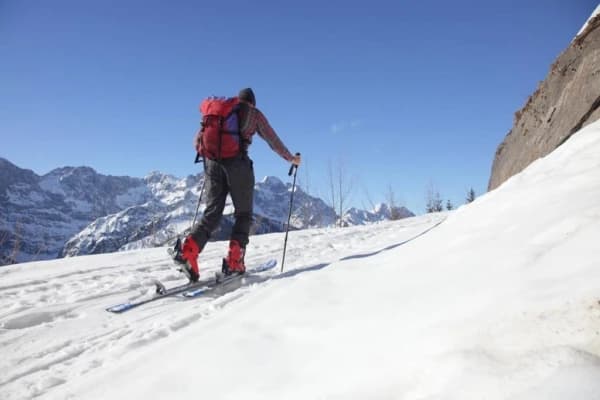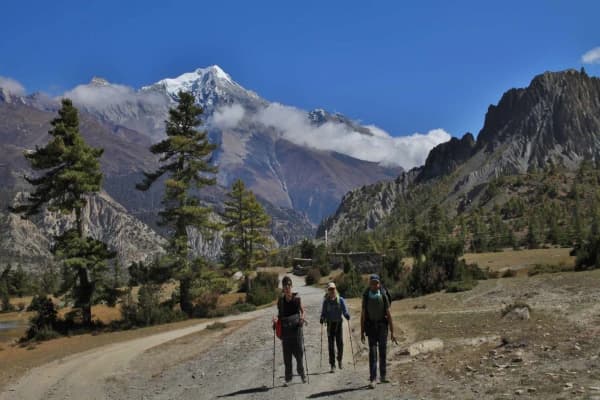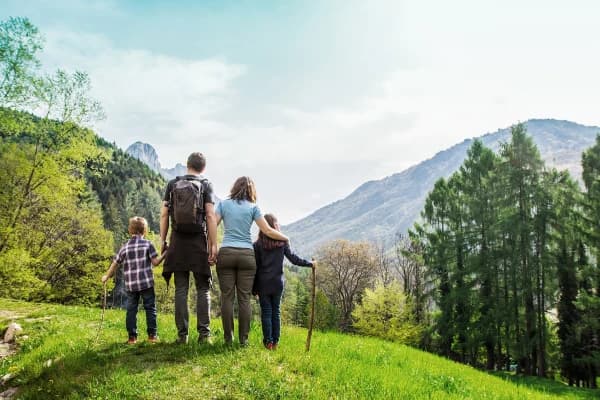The Khopra Ridge Trek is situated in the Annapurna region of Nepal. It is located just off the main trails that thousands of people flock to each season, resulting in a peaceful atmosphere rather than chaos. This is one of the things trekkers love about this trek. It is often missed by the majority of trekkers and is a unique blend of solitude and scenery in a mainstream region.
The Khopra ridge trail lies between the more famous Ghorepani Poon Hill and the Dhaulagiri range and passes through forests of rhododendrons, charming Gurung and Magar villages, and high alpine meadows. The final destination is the open skies of Khopra Danda, a panoramic balcony at 3,660 meters. But how challenging is the Khopra Ridge Trek? Do not let the quiet of the trail fool you; the Khopra Ridge Trek is a challenging 7 to 10-day trek that might surprise you as you move forward towards the journey. On the surface, the trail appears to be a gentle escape, but there is more to the Khopra Ridge Trek than meets the eye.
Let's discuss it to find out more!
How Difficult is the Khopra Ridge Trek?
This is moderately challenging, the Khopra Ridge Trek is ideal for people with average fitness levels and for people with a little bit of trekking experience means intermediate can trek this. You can expect gentle ascents, stone steps, and a few steep climbs, particularly near Khopra Danda and the holy Khayar Lake (4,660m).
While many Himalayan treks are known for their high altitudes and challenging terrain, Khopra Ridge stands out for its own reasons: the balance between the challenge and the serenity, the physical and mental fortitude it demands, and the reward of peaceful trails, stunning Himalayan vistas, and a genuine cultural immersion that you cannot find on most other treks.
What makes it challenging and how to handle it?
1. Altitude Factor
The Khopra Ridge Trek is considered to be an intermediate trek, with the highest point at 3,660 meters, which is generally accessible to most trekkers with proper acclimatization; however, due to the sharp and intermittent elevation gain, the Khopra Ridge trail is more challenging than routes that provide a gradual climb, with some of the steepest sections being from Tadapani to Bayeli Kharka and then to Khopra Danda, where there are several steep ascents followed by flatter sections, making the climb feel more strenuous than if it was just a longer distance.
Altitude sickness is rare on this trek, but it can happen if you ascend too rapidly and do not allow your body to adjust. The key to managing these elevation changes is listening to your body, so stay hydrated, and keep a steady rhythm.
2. Trail Conditions and Weather Challenges
The Khopra Ridge Trek is on well-established trails but it can be challenging, especially during the monsoon when the trails are muddy and slippery, and in winter when there can be snow along the route. We highly recommend trekking boots with good grips.
The best part of this trek is the open, exposed ridges, with sweeping views of Annapurna and Dhaulagiri giants, but these sections can be tough in bad weather (e.g. cold rain, strong winds) when you are not properly prepared with layers and wind protection, so make sure to be prepared.
3. Isolation of Trail and Lack of Infrastructure
The Khopra Ridge Trek is known to be more peaceful and isolated than some of the busier routes, as it winds through quiet villages and remote landscapes far from the crowds. You will often find yourself surrounded by nothing but nature, which is the best part of this trek.
But remember this means, there are fewer lodges and basic facilities, with limited medical help in few areas, so you need to prepare to be a bit more self-reliant and adapt for simple accommodations, but that is the beauty of the journey; The Khopra Ridge Trek reminds you what it feels like to step away from comfort and to trust your instincts and stay resilient in the raw side of the Himalayas.
4. Daily Trekking Demands and Fatigue Management
The Khopra Ridge Trek will have you walking between 5 and 7 hours per day, depending on your pace and itinerary, and although each day is not overwhelmingly challenging, the cumulative demand of trekking day after day, with steep climbs, long walks, and little time for full rest, is an essential part for recovery.
It is not one large hill that makes the trek hard but the accumulation of effort over several days. You may notice that your legs are a little heavier and your energy a little lower by the last few days, but pacing yourself, taking regular short breaks, and maintaining a steady pace rather than a fast one will make the trek much more enjoyable and your views at the end is even more rewarding.
5. Mental and Physical Endurance
The Khopra Ridge Trek is not only a physical challenge, but also a mental and emotional one. The steep climbs, changing weather, high altitude, and stretches of solitude will require you to find motivation within yourself, as there will not always be a crowd of trekkers to keep your spirits high, and this quiet endurance can be as challenging as the physical effort itself.
However, it can be just as rewarding; every time you overcome fatigue or doubt, you gain resilience and confidence that will carry with you well beyond the trek.
What you can expect from Khopra Ridge Trek in different seasons?
Autumn (Sep-Nov):
- Excellent Views: With clear skies and cool air, autumn offers some of the best views of Annapurna and Dhaulagiri.
- Easy to Hike: Weather is stable, making trails easier and more enjoyable to hike.
- Bright Landscapes: The forests and foliage are at their most colorful during this season, making it the prettiest time to trek.
- Cold Nights: At high altitudes, temperatures may fall below freezing, so warm clothes and a good sleeping bag are important.
- Brisk Mornings: Early mornings can be chilly, so you will need layered clothing.
- Thinner Air Above 3,000m: Recovery can be slower, and exertion may feel harder at high altitudes, so make sure to pack the proper thermals, gloves, and layering to ensure comfort and safety.
- Moderate: The trek is doable for most fit trekkers, but preparation and pacing will be necessary to fully enjoy the trek.
Spring (Mar-May):
- Vibrant Scenery: Rhododendron forests are in bloom, making spring the most colorful season.
- Very Comfortable Temperatures: Daytime conditions are mild and comfortable for trekking.
- Snow Patches: Higher areas such as near Khayar Lake may still have patches of melting snow, so I advise you to be caution.
- Morning Fog: Foggy mornings may obscure mountain views for a time.
- Trail Conditions: Trail conditions may be moist and slippery, affecting your footing.
- Essential Gear: Trekking poles and boots with good traction are advised, and overall spring is a gentler season than others, striking a balance between comfort and adventure.
Winter (Dec-Feb):
Solitude and Serenity: Winter offers peaceful trails and quiet landscapes, perfect for those seeking a deeper connection with the Himalayas.
Snow-Covered Trails: Paths above 3,000 meters are often deeply snow-covered, making trekking more challenging.
Limited Facilities: Many high-altitude teahouses may be closed, so planning ahead is essential.
Rapid Weather Changes: Winter weather can shift quickly, increasing the risk of cold-related fatigue.
Essential Gear: Microspikes, extra insulation, and layered clothing are necessary for safety and comfort.
Mental and Physical Challenge:Trekking in winter demands strong mental grit and cold tolerance, so it is only suitable for well-prepared trekkers.
Unique Experience: Despite the difficulties, winter provides an intimate, almost untouched Himalayan adventure if you are ready to embrace it.
Monsoon (Jun-Aug):
Lush Scenery: The trail is aesthetically spectacular, with waterfalls at their height and forests a vivid green.
Solitude: This time of year offers a peaceful, off-the-beaten-path experience because few hikers venture there.
Muddy and Slippery Trails: Wooden bridges are dangerous, footing is unstable, and paths become slick due to frequent rain.
Lower Trails at Risk for Leeches: Lower trails may be at risk for leeches, necessitating vigilance and appropriate protection.
Diminished Visibility: Rain and fog can obscure views, making it difficult to navigate and appreciate the scenery.
Emotional and Physical Challenge: Muddy conditions, soggy trails, and wet equipment can sap motivation and stamina.
Preparation is Important ! Remember that the key to enjoying the trek safely is mental toughness, rain gear, and cautious pacing. So no matter what season you go, nothing can stop you.
Note: We highly recommend you to hire a local guide or porter for better navigation, cultural insight and support.
How is the Khopra Ridge Trekkig Trail?
Here is a brief information on what you can expect:
Trails in the Forest:
Some parts are damp, mossy, and full of stone steps, but the lower portions wind through forests of oak, pine, and rhododendron, which are fragrant and peaceful.
Alpine Meadows:
Large meadows and highlands are accessible from mid-range zones. Although the exposed paths are beautiful, they put your strength and balance to the test, particularly during strong winds.
Ridge Walks:
Although walking along the ridges provides 360° views of the Himalayas, it is completely exposed with no cover or shortcuts, necessitating endurance and concentration.
Extension of Khayar Lake:
There are loose rocks and gravel paths along this high-altitude section. Although it is technically easy, it is where you get tired, but the reward is one of the most beautiful views on the trek.
Why is Khopra Ridge Trek Worth the Trouble?
Although it is a moderately difficult trek, you will be offered 360° Himalayan views of Dhaulagiri, Annapurna South, Nilgiri, and Machhapuchhre (Fishtail) from Khopra Ridge. The trek also takes you through cultural Gurung and Magar villages, rhododendron forests, and remote viewpoints untouched by the rest of the tourist crowd.
Additionally, the local community lodges along this trail are run by local people, so your trek is directly supporting sustainable tourism and rural livelihoods. When you reach there you will understand how hard it is for locals to survive on a day-to-day basis in the remote mountain area.
So when you are visiting Khopra Danda, you're not just making a memory of a lifetime but also giving financial support to local businesses.
Who can do the Khopra Ridge Trek?
This hike is ideal for intermediate hikers who are looking for a more sedate option to well-traveled paths. It is also suitable for small groups or families who are seeking a moderate challenge.
If you are an adventurer seeking genuine cultural experiences as well as mountain scenery this is your trek! The Khopra Ridge Trek is doable if you frequently hike, jog, cycle, or walk.
Khopra Danda Trek is also for those who are hungry for perfect nature photographs and nature lovers. They just have to make sure they can walk for 6 hours a day on average.
Solo travelers love the Khopra ridge trek route as well.
Even teenagers or elderly individuals can do it comfortably if they are healthy and accustomed to walking for a couple of hours every day.
Remember, prior trekking experience is not required as long as you have the will to undergo physical training
Final Thoughts,
If you are looking for serene trails, genuine experiences, and breathtaking Himalayan views, Khopra Ridge is a hidden gem worth exploring for you. The Khopra Ridge Trek strikes the ideal mix between accessibility and adventure. It's demanding enough to feel rewarding, but not to the point where professional experience is necessary.
Pre-trek fitness preparation, including cardio, stair climbing, and leg-strengthening activities, can have a significant impact in a few weeks so we recommend you consider it. This trek will challenge your endurance just enough, regardless of your level of experience, and reward you with lifelong memories and breathtaking views.
Are you planning your next adventure to Khopra Ridge? Feel free to reach out to us on www.ammoniteadventure.com for more information and travel arrangements.
FAQ’s
Why is the Khopra Ridge Trek different from other treks?
The Khopra Ridge Trek reaches a unique level of difficulty balance. It is slightly more difficult than lower-altitude treks like Ghorepani Poon Hill or Mardi Himal, but it is easier than high-altitude treks like the Everest Three Passes or Annapurna Circuit in terms of longer altitude exposure.
The primary cause is the rapid elevation gain, hikers arrive at Khayar Lake at 4,660 meters in a comparatively short amount of time. It is comparable to treks like Langtang Valley or Gokyo Ri in terms of overall seriousness and the requirement for strategic acclimatization; therefore, careful planning and pacing are crucial for a safe and enjoyable trip.
Is Acute Mountain Sickness a Risk During Khopra Ridge Trek?
Indeed, AMS poses a risk along this path, but in a secret and shady manner. Rarely does the Khopra Ridge route linger over 4,000 meters. Unlike some other well-known high-altitude treks, it doesn't immediately raise concerns about altitude.
But AMS is still a possibility, particularly if the hike is rushed. AMS symptoms may also be triggered by trying the Khayer Lake detour after getting enough sleep at Khopra Danda. Spending an additional night at Khopra Danda, staying hydrated, and gradually climbing from lower elevations are the best ways to acclimate. Additionally, you should pay attention to your body rather than your schedule.
Is it Technically difficult to do Khopra Ridge Trek?
You don’t need ropes, crampons, or specialized alpine gear to complete the Khopra Ridge Trek -all you need is a sturdy pair of trekking shoes, endurance, and sure footing. This isn't a walk in the woods, though.
To endure the long days on the trail, you must be in reasonable physical condition. Being mentally present is equally important. The trek gradually wears you down by testing your endurance day after day rather than posing a technical challenge. It is a journey that rewards patience, resilience, and the will to keep going forward, one step at a time.
Just imagine it as a silent conversation between your resolve and the mountain's constant determination.
What should I pack for the Khopra Ridge Trek?
The following items must be on the Khopra Ridge Trek essential packing list:
1. Cozy cotton clothing (pants and t-shirts)
2. Fleece jackets
3. A durable pair of hiking boots
4. Duffle bags
5. An appropriate first aid kit with the required prescription medication
6. A high-quality sleeping bag
7. Climbing pole (optional)
8. Sun hats and woolen hats
9. Cotton and wool socks
10. Hand warmers and gloves
11. A sunhat
12. Sunblock
13. Water purifiers and bottles
Remember that you should only ever drink boiled or purified water. Additionally, duffle bags and clothing that repels water can be very helpful.






